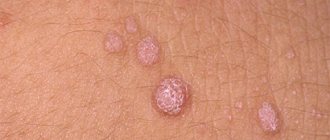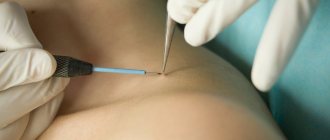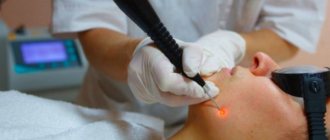Papilloma is a small growth on the skin or mucous membranes , from 1 to 5 mm in height, but there are also larger formations.
The appearance depends on the type of pathogen, which is human papillomavirus . There are more than 70 types of HPV.
On mucous surfaces, neoplasms most often look like inflorescences resembling cauliflower. Such growths sometimes form entire colonies.
On the skin it can be a single plaque, sometimes on a thin stalk. Color - from flesh to dark brown.
Photo 1. Papillomas cause psychological discomfort, so it is recommended to remove them. Source: Flickr (The Skin Clinic, INC).
Predisposing factors
The following factors contribute to the active growth of papillomas:
- frequent change of sexual partners, infection with sexually transmitted diseases;
- household contacts with people who have warts, condylomas or papillomas;
- damage to the skin and mucous membranes;
- weakening of the immune system.
80% of people who have reached puberty have HPV in an inactive form. The virus does not cause tumor growth until 6-8 months after contact with the virus carrier. The exception is condylomas and papillomas on the genitals - they appear in the first weeks after intimate contact with an infected person.
How to recognize flat papilloma
To understand what flat benign papilloma looks like, you need to be familiar with its characteristics. The following features clearly stand out in the appearance of this neoplasm:
- The diameter of the growth is in the range of 8-10 mm;
- Protrudes slightly above the surface of the skin;
- Has a different shade. Usually papillomas are light beige or brown;
- They are distinguished by a rough surface and keratinized epithelium on top;
- They have a round shape without folds.
If a person is infected with papillomavirus, he should remember these symptoms. They will help, if flat rashes appear, to immediately determine their type even before visiting a dermatologist’s office.
Flat papilloma practically does not protrude above the skin
Why remove papillomas
Papillomavirus poses a serious health threat. Strains with a high oncogenic risk are especially dangerous: 16, 18, 30, 31-35, 56-59, 67-68. If papillomatous growths appear, you should contact a dermatologist or venereologist. The doctor will conduct an external examination and prescribe PCR diagnostics, which will reveal the DNA of the virus and determine the degree of oncogenicity of a particular strain.
The specialist will also select the most effective surgical techniques. Only a doctor, having the examination results in hand, can tell exactly how to remove papillomas with minimal risks to health. It is not recommended to leave such neoplasms. Under the influence of unfavorable factors, they can become inflamed, bleed, and cause benign or malignant tissue hyperplasia.
Important! It is imperative to remove papillomas in intimate places - this is where neoplasms of high oncogenic risk most often appear.
If papillomatous growths are detected on the external genitalia (vulva, perineal area, foreskin), you should consult a venereologist. Additionally, it is worth taking tests prescribed by your doctor, the purpose of which is not only to establish the type of HPV, but also to detect concomitant urogenital infections.
Surgical treatment of papillomas
The main methods of surgical treatment of papillomas:
- the use of special local means with which you can remove papillomas at home;
- cryodestruction (removal of papillomas with liquid nitrogen);
- laser coagulation (removal of papillomas with a laser);
- radio wave removal of papillomas;
- excision of formations with a scalpel.
Any of the listed methods can remove papillomas. The specialist will help you choose the appropriate option, taking into account the location of the tumor, the number of papillomatous growths and diagnostic data. Before removing papillomas, the doctor must make sure that there is no malignant process. If there is a high oncogenic risk, experts prefer the classic method of removing papillomas - excision of tumors with a scalpel.
Main indications for removal of papillomas:
- the desire to get rid of a cosmetic defect in the form of single or multiple papillomatous growths on the skin and mucous membranes;
- frequent damage to tumors that are located under the armpits, on the neck, in the inguinal folds, bleed and become inflamed, leading to an increased risk of tissue malignancy;
- detection of papillomas of medium and high oncogenic risk;
- the presence among relatives of people with neoplasms of a malignant nature;
- The location of papillomas is the genitals and internal genital organs.
Where can papillomas be removed?
Removal of tumors is carried out in sterile conditions of medical clinics .
The removal procedure must be preceded by a consultation with a dermatologist. Such a doctor can be found both in a regular clinic and in specialized medical clinics and centers. He will examine the growth and select a method for removing it.
It is important to know that:
- if papillomas are localized on the face and décolleté, consultation with a cosmetologist may be required;
- before removing tumors on the genitals and anus, an examination by a gynecologist, urologist and proctologist will be required, respectively;
- if tumors are found in the nose or throat, you will have to see an ENT specialist.
- If malignancy is suspected, consultation with an oncologist is necessary.
The ideal time to remove papillomas
Before removing papillomas on the body and face, the doctor warns the patient about possible complications, including the formation of age spots. The risk of pigmentation is higher in the spring and summer. Many people are interested in whether it is possible to remove papillomas in the summer. If the formations are located on open areas of the body or on the face, it is better to postpone the operation until the cool season, when the likelihood of a secondary infection and the formation of pigmentation is lower (the activity of UV rays is reduced in the autumn-winter period).
Important! It is not enough to simply remove the tumor; this will not stop the growth of the papillomavirus. Surgical methods must be combined with therapeutic ones.
It is impossible to completely get rid of HPV - the virus will still remain in the body in small quantities. But in combination with antiviral agents, surgical methods provide the highest possible treatment results.
Is it possible to get rid of papillomas forever?
Taking into account the number and variety of methods to combat papillomas, the conclusion arises that this problem is not so easy to solve.
In fact, by removing a tumor, it is impossible to guarantee one hundred percent getting rid of it forever, because papilloma itself is only a consequence, and the cause is the presence of HPV in the body .
The fight against viruses is based on the formation and maintenance of normal immunity. Therefore, when getting rid of papillomas, it is important to understand that a relapse will not be long in coming if the immune system is not in order.
The best way to solve the problem is an integrated approach - contacting a doctor and strictly following all points of the prescribed treatment, including taking immunomodulatory drugs.
Laser removal of papillomas
Laser removal of papillomas is a modern method of surgical treatment of HPV. Most often, specialists use carbon dioxide laser systems. After the procedure, there are no scars or defects left on the skin. The high price of laser papillomas removal corresponds to the effectiveness of the method. The final cost depends on the size and number of tumors. At a time, the doctor can perform laser destruction of up to 5-20 medium-sized formations. After examination and consultation, the specialist will tell you exactly how much it costs to remove papillomas and give detailed recommendations. Additionally, antiviral treatment is mandatory. The attending physician also selects the medications.
Using a laser, you can remove papillomas on any part of the body, including the genitals. This method is bloodless and contactless. The laser has an anti-inflammatory effect on tissue, seals blood vessels, preventing bleeding. Most often, papillomas appear on the hands (warts) and on the neck - in the form of thread-like outgrowths that are easily damaged during hygiene procedures. Such neoplasms do not have a high oncogenic risk, but it is still better to get rid of them. More information about how to remove papillomas on the neck can be found in a separate article.
Features of laser papillomas removal
Before the procedure, a dermatologist is consulted. The doctor examines the skin and identifies possible contraindications:
- tissue damage;
- local inflammation of the skin and mucous membranes;
- pregnancy;
- exacerbation of any infectious processes;
- herpes.
During laser removal of papillomas, semiconductor lasers are used, which evaporate viral tumors and at the same time coagulate blood vessels. After the destruction of the papillomamatous growth, a protective crust (eschar) forms on the skin. It is rejected on its own a week after removal. 2 months after the procedure, the skin tone is completely evened out. The place where the papillomas were will be no different from the adjacent tissues.
Skin care
The scab formed after laser removal of papilloma must be protected from sunlight, water and cosmetics. It is forbidden to try to tear off the crust forcibly - this can lead to wound infection, severe scarring and an increase in tissue healing time.
After the scab comes off, it is recommended to lubricate the skin with sunscreen before going outside. This will prevent the formation of age spots. During the winter months, it is not necessary to use sunscreen cosmetics.
Removal of papillomas with nitrogen
Removal of papillomas with nitrogen involves freezing the tumors (cryodestruction). The method is effective for single papillomatous growths on the skin. A significant disadvantage of cryodestruction is the inability to control the depth of tissue freezing. Therefore, it is so important to take a responsible approach to choosing a clinic where you will have to remove papillomas. The doctor must have permission to perform surgical activities.
Ultra-low temperatures stop metabolic processes in neoplasm cells, causing their death. At the site of the removed papilloma, a necrotic area forms, which is gradually replaced by healthy tissue. Cryodestruction is available to most patients. The procedure is much cheaper than other methods (laser coagulation, radio wave removal of tumors).
Papillomas can be removed both for aesthetic reasons and if there are specific indications. Of particular concern are neoplasms that sharply increase in size, change shade and shape, become inflamed, and are injured during hygiene procedures.
Features of cryodestruction
Before removing papillomas with liquid nitrogen, the doctor carefully examines the skin, assesses the general state of health, and identifies possible contraindications:
- acute infectious processes;
- decompensated stage of somatic diseases;
- exacerbation of skin diseases;
- herpes;
- tissue damage in the area where the tumor is located;
- pregnancy period.
Removal of papillomas with nitrogen is carried out without anesthesia. The cryodestructor applicator is held over the tumor for 1-2 minutes. The skin becomes white and cold, and temporarily loses sensitivity. During the procedure, a slight tingling sensation occurs and a burning sensation may occur. Within a few hours after the procedure, the skin swells and turns red, and within a day after cryodestruction, bubble elements appear on the treated area, inside of which there is serous fluid.
Tissue cryonecrosis continues for up to a month, after which the dead areas of the neoplasm are rejected, and in their place imperceptible spots appear, which will completely disappear 3-5 months after using liquid nitrogen.
Skin care
During the first weeks after removal of papillomas using cryodestruction, it is recommended to protect the skin from moisture, sunlight and other adverse factors. If severe inflammation occurs, you should consult your doctor. Usually the tissues heal on their own, but if the rate of epithelization is low, the doctor may recommend cosmetics that accelerate the regeneration of damaged skin.
Removal of papillomas by electrocoagulation
Electrocoagulation of papillomas involves removing growths on the skin using electric current. The method is quite traumatic, but has an affordable cost. High-frequency current coagulates tumor proteins, causing tissue rejection.
Features of the procedure
Before electrocoagulation, a specialist may prescribe dermatoscopy, PCR and other laboratory diagnostic methods. The doctor conducts an examination and identifies possible contraindications:
- exacerbation of herpes infection and any inflammatory processes;
- pregnancy;
- suspicion of a malignant nature of papillomas;
- excessive skin sensitivity, allergic reaction to electric current;
- exacerbation of severe somatic diseases, especially those in the stage of decompensation.
Skin care
Electrocoagulation of papillomas does not require any complex skin care. It is necessary to avoid the action of predisposing factors that can provoke inflammation and secondary infection. During the first weeks, the resulting scab is rejected, after which the skin is completely cleansed and replaced with new cells. It is necessary to avoid exposure to direct sunlight during this period. The doctor may recommend treating the wound with a weak solution of potassium permanganate.
Radio wave removal of papillomas
Removal of papillomas using the radio wave method is accompanied by an atraumatic incision and coagulation of neoplasm tissue. Radio waves provide high-precision effects, while they do not injure healthy tissue and inhibit the spread of HPV through the bloodstream. Radiosurgical devices used in modern clinics are safe and can minimize the risk of any complications.
Features of the procedure
Preliminary diagnosis allows you to determine the amount of virus in the body, the type of HPV and the degree of oncogenic risk. When choosing a treatment method, the doctor takes into account the general state of health and identifies possible contraindications:
- pregnancy, menstruation;
- exacerbation of any infectious and inflammatory processes and somatic diseases;
- the presence of malignant tumors;
- exacerbation of herpes infection;
- skin damage at the site of exposure to the radio wave apparatus.
High-frequency energy cuts the skin, coagulates blood vessels and papilloma tissue. In this case, the electrode does not have direct contact with tissues, which avoids pain and muscle spasms. Unlike the electrocoagulation method, when using radio waves it is possible to reduce the time of thermal exposure and reduce necrosis of the treated areas.
Skin care
The procedure is performed under local anesthesia. Removal of papillomas lasts only 15-30 minutes. In place of the treated tissue areas, pinpoint scabs remain, which after a week are torn off on their own, leaving no rough scars or other defects. During the recovery period, it is recommended to limit contact with water and ultraviolet rays; you should not use cosmetics and household chemicals.
Reasons for appearance
All types of tumors are caused by different strains of HPV, divided according to the degree of cancer development. The varieties of the virus responsible for the appearance of flat papillomas are strains 3, 5 and 10 . They belong to non-oncogenic types.
However, this does not mean that the growths that appear do not pose a danger. A flat tumor is easy to injure: rub it with clothes, scratch it, hit it with a razor. The injured area is vulnerable to microbes, the appearance of which contributes to inflammation and infection.
HPV has several forms of transmission. The active strain is determined based on the method of infection. There are 3 main routes of infection:
- Sexual. Papillomavirus is one of the most common sexually transmitted diseases. Unprotected sexual intercourse leads to a high probability of infection at the first contact. You can catch the infection through vaginal, oral and anal sex. However, even a condom is not able to completely protect against the virus.
- Contact and household. HPV is easily transmitted from a sick person to a healthy person in public places. Swimming pools and bathhouses that have a humid environment become fertile environments for the spread of the virus. You can also become infected through objects that belong to an infected person: towel, razor, bed linen, etc. Viral particles enter the body if there are wounds or microcracks on the surface of the skin. This method of infection is typical for low-oncogenic types.
- Perinatal. Infection occurs when a child passes through the natural birth canal. Performing a caesarean section minimizes the risk of transmitting the virus. In this case, infection of the fetus in the womb is excluded.
Surgical excision with a scalpel
Removal of papillomas with a scalpel during classical surgery is used quite rarely, mainly when signs of malignancy of the tumor are detected. In this case, the surgeon excises the papillomatous growths, capturing healthy skin.
The method is traumatic and leaves scars and stains. If desired, they can be removed using laser and other cosmetic procedures, including acid peels. Experts try not to use surgical excision of papillomas on open areas of the body and face.
Prevention
The best prevention of papillomas is to strengthen the immune system. Vitamin complexes and proper nutrition, which includes foods enriched with beneficial microelements, help cope with this task. You can also drink herbal teas in courses, which have an immunostimulating effect.
Flat papillomas on the face are nodules on the skin that protrude slightly above its surface. Neoplasms of a viral nature are usually painless, but bring a lot of psychological discomfort. Especially if they are on visible parts of the face.
Products for removing papillomas
Medicines for removing papillomas and warts act in the same way: they contain substances that cause the destruction of neoplasm cells with the subsequent formation of a small scab. It is recommended to use modern drugs that have a lower risk of complications such as secondary infection, acute inflammatory reaction, spots and scars. It is also possible to use cryotherapy agents that can replace standard cryodestruction.
Removing papillomas at home is quite dangerous, especially for large tumors. It is better to contact specialists who will select the best treatment options, including antiviral therapy, which prevents relapses of human papillomavirus infection in the future. A professional will tell you exactly how to remove papillomas at home and whether it is worth doing. Preparations for local application to skin growths are used for single small tumors.
Common medications for removing papillomas at home:
- Solcoderm. The product is based on 4 types of acid (acetic, lactic, oxalic and nitric). One ampoule is usually enough to remove 3-5 formations. The drug has an applicator with which it is easy to precisely apply liquid to papillomas. Accidental contact of the product with healthy skin should be avoided.
- Super clean. The drug contains celandine juice and alkalis that can destroy neoplasm tissue. If handled carelessly, such products can cause chemical burns and rough scars.
- Verrucacid. It has a cauterizing effect, but has a moderate concentration of active substances. The drug is applied with a wooden stick several times in a row, allowing the last layer to dry. The product is released in a dark bottle. Before application, healthy areas must be lubricated with a thin layer of zinc paste.
- Cryopharma. The product is released in the form of an aerosol. The cryopreparation can be used to remove papillomas and small warts. It is applied to the applicator and applied to the tumor for 20-30 seconds. After 2 weeks, the procedure can be repeated if it does not bring the expected effect.
Since it is not always possible to remove papillomas only with the help of pharmaceutical products, it is still recommended to consult a dermatologist. For small tumors, the doctor may recommend proven drugs that will destroy papillomatous growths. Additionally, it is recommended to use antiviral agents. An integrated approach increases the efficiency of the entire treatment process. You can do without antiviral drugs only if the papillomas are single and not prone to proliferation and malignancy.
Removal of papillomas using traditional methods
Removing papillomas using folk remedies at home is popular. Society does not take papillomavirus seriously enough. Many people don’t even know that papillomas can become malignant. Since it is almost impossible to remove papillomas at home without risk to health, it is recommended to first consult a dermatologist. Using modern diagnostic methods, the doctor will be able to assess the nature of the tumor and select an effective treatment regimen.
Common methods for home removal of papillomas
You can remove papillomas at home using the following means:
- celandine juice;
- garlic;
- green walnut juice;
- salicylic acid.
Important! The methods listed above destroy growths on the skin. The use of such products on mucous membranes is strictly prohibited due to the high risk of acute inflammatory reaction and chemical burns.
Most often, celandine juice is used to remove papillomas. The affected areas of the skin are treated with this remedy several times a day. However, celandine should not be applied to healthy tissue. To prevent burns, it is recommended to treat unaffected skin with vegetable oil or zinc ointment before using the juice.
Garlic has a disinfectant effect and, with prolonged use, helps remove warts and papillomas. But this method is not suitable for people who have sensitive skin. Garlic often causes inflammatory reactions, causing burning and hyperemia.
Salicylic acid helps destroy skin growths caused by the active reproduction of papillomavirus. This remedy is often included in ready-made preparations for getting rid of papillomas and warts. Salicylic acid is applied pointwise several times a day until the tumor dies completely.
The juice of green walnuts greatly stains the skin. The product must be used for a long time to achieve the death of papilloma. The treated fabrics acquire a dark brown tint, peeling and dry skin may occur.
Features of the treatment of flat warts in children
Treatment for flat growths in children and adults is no different. But when treating warts in children, you should follow the following precautions:
- When using celandine (freshly picked or pharmaceutical), you should check whether your hands are washed before eating so that any remaining product does not get inside;
- It is recommended to refrain from products that contain aggressive components (acids or alkalis) - super cleanser, salipod. Such drugs can provoke the appearance of scars;
- Electrocoagulation and nitrogen treatment are also not used in the treatment of children;
- The optimal method of treating flat growths in children is the use of local antiviral agents (Panavir gel) or the use of laser destruction.
When the first signs of infection with papillomavirus appear, you should immediately visit a dermatologist. A qualified doctor will prescribe the necessary clinical studies, specify the strain of the causative virus and recommend the optimal treatment.










